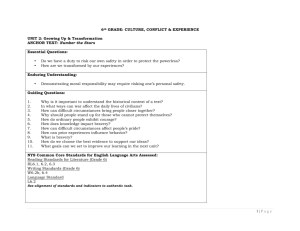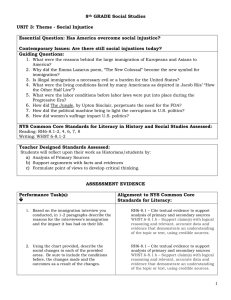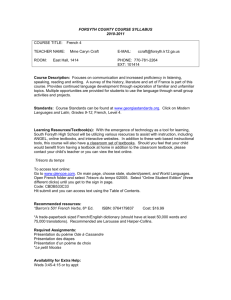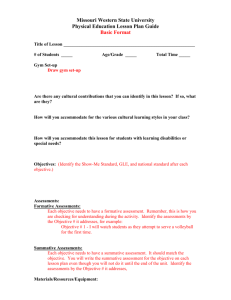7th GRADE SCIENCE
advertisement
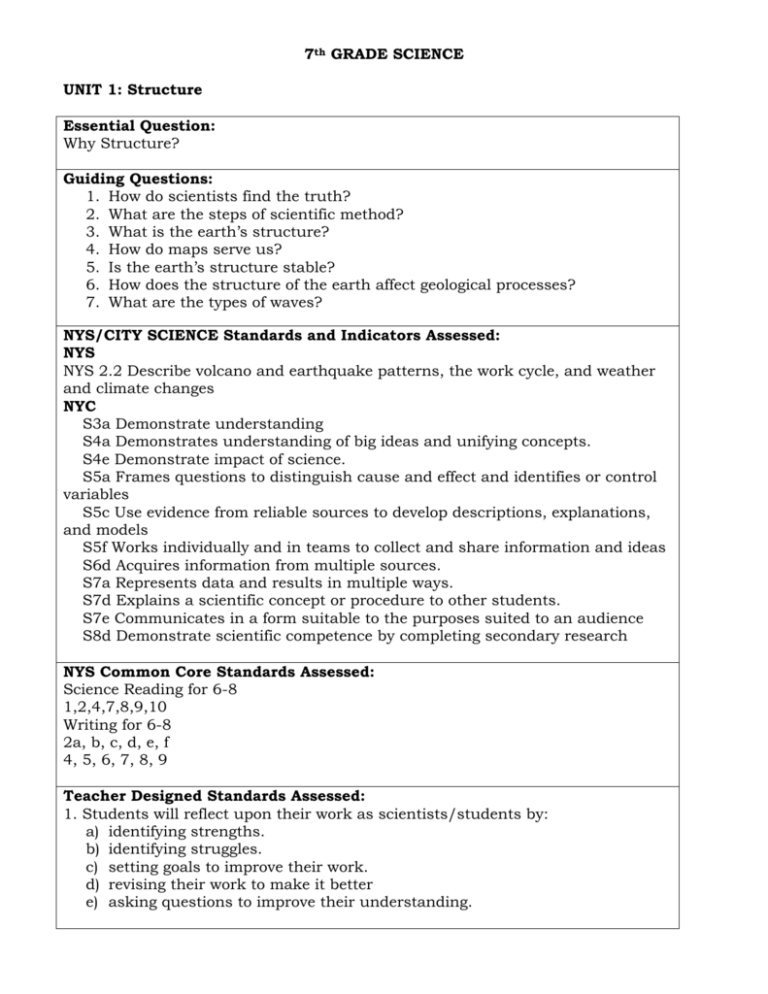
7th GRADE SCIENCE UNIT 1: Structure Essential Question: Why Structure? Guiding Questions: 1. How do scientists find the truth? 2. What are the steps of scientific method? 3. What is the earth’s structure? 4. How do maps serve us? 5. Is the earth’s structure stable? 6. How does the structure of the earth affect geological processes? 7. What are the types of waves? NYS/CITY SCIENCE Standards and Indicators Assessed: NYS NYS 2.2 Describe volcano and earthquake patterns, the work cycle, and weather and climate changes NYC S3a Demonstrate understanding S4a Demonstrates understanding of big ideas and unifying concepts. S4e Demonstrate impact of science. S5a Frames questions to distinguish cause and effect and identifies or control variables S5c Use evidence from reliable sources to develop descriptions, explanations, and models S5f Works individually and in teams to collect and share information and ideas S6d Acquires information from multiple sources. S7a Represents data and results in multiple ways. S7d Explains a scientific concept or procedure to other students. S7e Communicates in a form suitable to the purposes suited to an audience S8d Demonstrate scientific competence by completing secondary research NYS Common Core Standards Assessed: Science Reading for 6-8 1,2,4,7,8,9,10 Writing for 6-8 2a, b, c, d, e, f 4, 5, 6, 7, 8, 9 Teacher Designed Standards Assessed: 1. Students will reflect upon their work as scientists/students by: a) identifying strengths. b) identifying struggles. c) setting goals to improve their work. d) revising their work to make it better e) asking questions to improve their understanding. ASSESSMENT EVIDENCE Authentic Performance Task(s): Alignment to NYS common Core Standards: Students will work in groups to… 1. brainstorm questions (genuine)/problems related to earthquakes 2. read, view videos about earthquake 3. use variables/factors related to earthquakes – choose a factor/variable to create new question—a testable/ researchable question with independent and dependent variables 4. read again, related to question and collect data 5. compare findings in data with published texts 6. draft written report, present to peers, get feedback from peers 7. revise 8. create a display/exhibit/pp/poster to educate peers Science Reading for 6-8 1. Cite specific textual evidence to support analysis of science and technical texts. 2. Determine the central ideas or conclusions of a text; provide an accurate summary of the text distinct from prior knowledge or opinions. 4. Determine the meaning of symbols, key terms, and other domain-specific words and phrases as they are used in a specific scientific or technical context relevant to grades 6–8 texts and topics. 7. Integrate quantitative or technical information expressed in words in a text with a version of that information expressed visually (e.g., in a flowchart, diagram, model, graph, or table). 8. Distinguish among facts, reasoned judgment based on research findings, and speculation in a text. 9. Compare and contrast the information gained from experiments, simulations, video, or multimedia sources with that gained from reading a text on the same topic. Writing for 6-8 2. Write informative/explanatory texts, including the narration of historical events, scientific procedures/ experiments, or technical processes. a. Introduce a topic clearly, previewing what is to follow; organize ideas, concepts, and information into broader categories as appropriate to achieving purpose; include formatting (e.g., headings), graphics (e.g., charts, tables), and multimedia when useful to aiding comprehension. b. Develop the topic with relevant, well-chosen facts, definitions, concrete details, quotations, or other information and examples. c. Use appropriate and varied transitions to create cohesion and clarify the relationships among ideas and concepts. d. Use precise language and domain-specific vocabulary to inform about or explain the topic. e. Establish and maintain a formal style and objective tone. f. Provide a concluding statement or section that follows from and supports the information or explanation presented. 4. Produce clear and coherent writing in which the development, organization, and style are appropriate to task, purpose, and audience. 5. With some guidance and support from peers and adults, develop and strengthen writing as needed by planning, revising, editing, rewriting, or trying a new approach, focusing on how well purpose and audience have been addressed. 6. Use technology, including the Internet, to produce and publish writing and present the relationships between information and ideas clearly and efficiently. 7.Conduct short research projects to answer a question (including a self-generated question), drawing on several sources and generating additional related, focused questions that allow for multiple avenues of exploration. 8. Gather relevant information from multiple print and digital sources, using search terms effectively; assess the credibility and accuracy of each source; and quote or paraphrase the data and conclusions of others while avoiding plagiarism and following a standard format for citation. 9. Draw evidence from informational texts to support analysis, reflection, and research. Diagnostic Assessments: -Individual response to essential question (pre) Formative Assessments: 1. research notes/science notebooks 2. drafts of questions 3. draft of report 4. responses to guiding questions (verbal and written) 5. quizzes 6. lab reports 7. observations during group work 8. class discussions Summative Assessments: 1. presentation/ display 2. portfolio 3. unit test 4. response to essential question 5. - quizzes TEACHING AND LEARNING PLAN Teaching and Learning Activities: 1. Use the essential question as a pre-assessment 2. Introduce unit vocabulary and have students use vocabulary strategies to learn the words. 3. Use the guiding questions to do lessons. 4. Introduce how to do secondary research project. 5. 6. 7. 8. Secondary research process. Guide students in doing the authentic task. Have students select portfolio pieces. Administer the unit test. Resources Needed: UNIT 1: Structure Essential Question:Why structure? Week Guiding Questions 1 1. How do scientists find the truth? WEEKLY CALENDARMay 25, 2011 Topics/Lessons Assessments (diagnostic, formative, summative, interim) 1. Individual Nature of science:, response to definition of essential question science, branches (pre) of science, characteristics of a 2. Research notes scientist (formative) Scientific law and Theory 3. Lab reports Tools and (graded) Laboratory Safety Types of Investigations: Secondary research project Key Vocabulary Science, science law, science theory, safety, secondary research, metric rules, triple beam balance, graduated cylinder Standards Assessed: Week Guiding Questions 2 2. What are the steps of the scientific method? Topics/Lessons Steps of scientific method Variables Assessments (diagnostic, formative, summative, interim) 1. Lab reports (graded & ungraded) 2. Quiz (graded) 3. Science notebook Key Vocabulary Scientific method, observation, inference, hypothesis, variables, graphs, conclusion, scientific reasoning— (formative) claim, evidence, reasoning Standards Assessed: Week Guiding Questions 3 3. What is the Earth’s structure? Topics/Lessons Layers of Earth Rocks and Rock Cycle Assessments (diagnostic, formative, summative, interim) 1. Class discussion (formative) 2. Lab reports (summative) 3. Science notebooks 4. Quiz Key Vocabulary Assessments (diagnostic, formative, summative, interim) 1. Interim Assessment: Nature of science, Scientific Method, Layers of Earth 2. Science Notebook (formative) 3. Ungraded quiz Key Vocabulary Assessments Key Vocabulary Structure, crust, mantle, core, layers, sedimentary rocks, igneous rocks, metamorphic rock, cycle Standards Assessed: Week Guiding Questions 4 3. What is the Earth’s structure? Topics/Lessons Weathering Soil Erosion Fossils Minerals Weathering—mechanical & chemical, erosion, fossils Standards Assessed: Week Guiding Questions Topics/Lessons 5 4. How do maps serve us? 5. Is the earth’s structure stable? using topographic maps Continental drift theory Plate Tectonics (diagnostic, formative, summative, interim) 1. Authentic Task begins. Students will work in groups to.. - brainstorm questions/genuine problems related to earthquakes - read/ view videos about earthquake - identify variables/factors related to earthquake - choose a factor or variable to create a testable/researchable question with dependent and independent variables. 2. drafts of testable questions (formative) Topographic maps, scales, latitude, longitude, viewpoints, prime meridians, equators, plates, continents, plate boundaries, ring of fire, plate tectonic, Pangea Standards Assessed: Week Guiding Questions 6 6. How does the structure of the earth affect geological processes? Topics/Lessons Formation of mountains and volcanoes Occurrence of Assessments (diagnostic, formative, summative, interim) 1. Authentic Task continues… - read again articles related to question - Key Vocabulary Folds, faults, earthquakes, seismograph, seismologist, intensity, seismologist, lava, Earthquakes comparefindings/data magma, epicenter, with published texts focus, magnitude, 2. group discussion tsunami (formative) Standards Assessed: Week Guiding Questions 7 7. What are the types of waves? Standards Assessed: Topics/Lessons types of waves properties of sound and light waves Assessments (diagnostic, formative, summative, interim) 1. Authentic Task continues… - draft written report, present to peers, get feedback on peers - revise - create a display/exhibit/pp/ poster to educate peers 2. Interim Assessment: Geological Processes, Topographic Maps, Light & Sound Waves, Formation of Mountains and Volcanoes, Plate Tectonics Key Vocabulary Seismic waves, sound waves, light waves, crest, trough, compression, longitudinal Week Guiding Questions Topics/Lessons 8 1) What are your strengths and struggles in learning scientific skills and processes? 2) What goals can you set to improve your learning in the next unit? Standards Assessed: setting goals comparing strengths and weaknesses reflections Assessments (diagnostic, formative, summative, interim) 1. Unit test 2. Portfolio Key Vocabulary Goals, strengths, science skills, weaknesses, science processes



